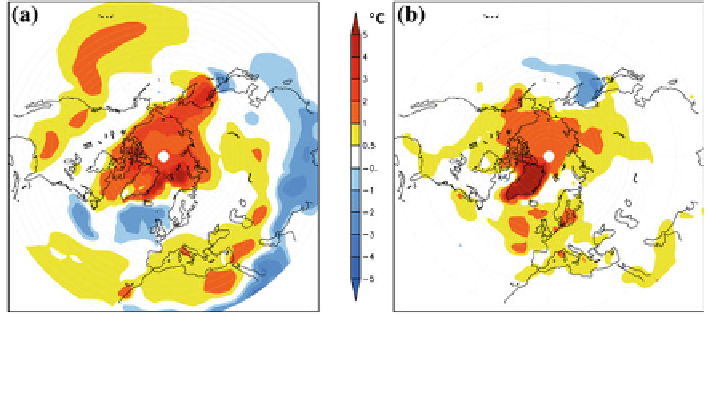Geoscience Reference
In-Depth Information
Fig. 2 Annual mean surface temperature anomalies for: a LIG minus the preindustrial control
simulation, b LIG with reduced GIS by 1,300 m minus LIG. For the run with reduced GIS, the
surface area and albedo have been consistently adapted
cycle. In high northern latitudes, an insolation-induced temperature increase is
further enhanced by increased ocean heat transport and reduced sea-ice cover,
resulting in an intensi
ed ocean heat release (Fischer and Jungclaus
2010
,
2011
).
During the LIG, the northern high latitudes showed summer temperatures higher
than those of the late Holocene, and a significantly reduced Greenland Ice Sheet
(GIS). We perform sensitivity studies for the height and extent of the GIS at the
beginning of the LIG (130 ka BP) using COSMOS. Our study shows that a strong
Northern Hemisphere warming is caused by increased summer insolation (Fig.
2
a).
Reduced GIS elevation by 1,300 m contributes to a further warming of the LIG
(Fig.
2
b). These changed model boundary conditions lead to an effect of similar
amplitude over high latitudes (up to 7
C) compared to the run with orbital forcing
°
only (Pfeiffer and Lohmann
2013
).
Another goal of our project was to provide new records of SST variability over
the last 3 millennia to evaluate Holocene transient simulations prescribed with solar
variability, volcanic forcing, and greenhouse gas concentrations. A new high-res-
olution record from the Benguela upwelling system has been generated. The SST
record pointed out that SST evolution over the past millennia in major upwelling
systems were negatively correlated with temperature changes observed over larger
regional scales because land-ocean interactions intensify Ekman pumping in
response to a regional warming (Leduc et al.
2010b
). In subsequent projects, we
will further examine the role of external forcing onto climate trends and how they
are recorded in proxy data.
Coupled general circulation models have been utilized to estimate the possible
range of amplitudes for future climate change. Validation of these models by sim-
ulating interglacial climate states is essential for understanding the sensitivity of the
climate system to external forcing. As a key issue in the
priority
program of the German science foundation, we evaluated the interglacial dynamics
by analyzing reconstructed and modeled SST trends in tandem. From our data-model
'
Interdynamic
'

Search WWH ::

Custom Search